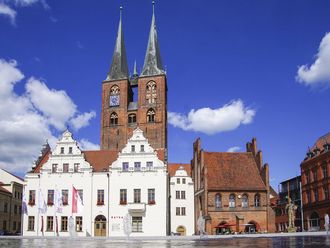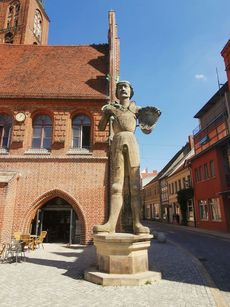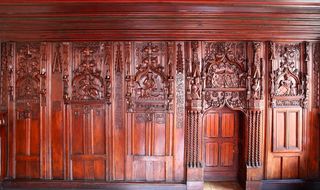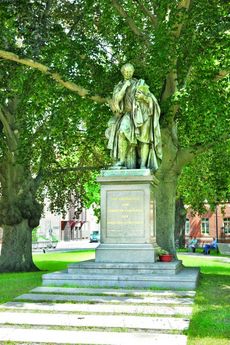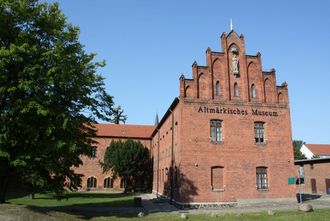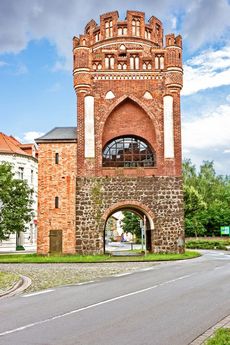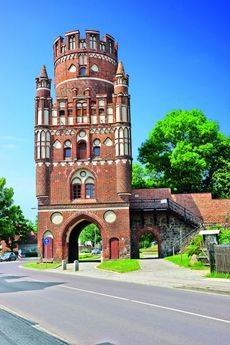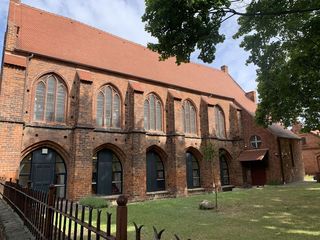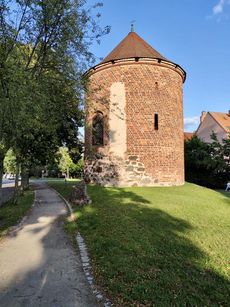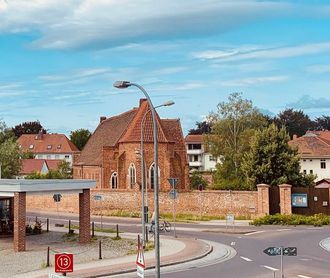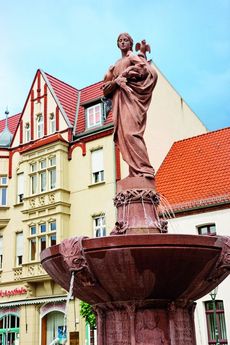MARKETPLACE
The marketplace is located in the centre of the city, right in front of the town hall. Albrecht “the Bear”, the famous margrave of Brandenburg, established the market in the years 1160/1165. Along with the market privilege, Stendal also received its town charter. Margrave Albrecht put Stendal under the Magdeburg Law, which means that the city was authorized to coinage, was free of taxation and had other important privileges. Because of its ideal location and various trade connections to many cities along the North and Baltic Sea, Stendal rose up to the largest city in the Mark Brandenburg. The unique historic ensemble of Town Hall, St. Marys Church and the Roland Statue still prove the former wealth of our Hanseatic City. It is said to be one of the most beautiful Brickstone Gothic ensembles in North Germany.
Roland
The Roland Statue represents the rights and liberty of medieval cities. Built in 1525 with a height of 7.8 meters (25.6 feet) it is the third biggest Roland Statue in Germany. Our Roland leans on a decorated column and holds up a sword in the right and a buckler in the left hand. On the buckler you can see an eagle, which is the code of arms animal of Brandenburg. Stendal is one of the oldest cities of the old Mark Brandenburg. Nowadays you see a remake of 1974 because the original was destroyed by a storm. The majority of its old fragments are exposed in the Altmärkisches Museum.
TOWN HALL
Building the Town Hall as you see it now took many centuries. The “Gerichtslaube”, which is the oldest part of the brick building, was built at the beginning of the 15th century. In ancient times, the arch cellar was used as a store and now you will find a coffee shop in there. In the middle of the 15th century, the Cloth Hall, a wing built by the guild of the tailors, enlarged the building. Our Little Hall keeps a treasure: a wooden-carved wall made in 1462, which said to be the oldest secular wooden wall in whole Germany. To visit this wall you may ask at the “Tourist-Information”.
At the end of the 19th century, the Town Hall was accomplished with the wing in front, which was built in Renaissance style.
WINKELMANNPLATZ
Behind St. Marys Church you will find the Winkelmannplatz. Under big trees, the Winckelmann Memorial was built in the year 1859. It commemorates of Johann Joachim Winckelmann, the famous son of our city. He is the founder of scientific archaeology and history of art. Born in 1717 as son of a poor shoemaker, he travelled across southern Europe and made his way into the Vatican. He became responsible overseer of Vatican antiquities. For more information, you may visit the Winckelmann Museum
MONASTERY GARDEN & ST.KATHARINEN CHURCH
The former Katharine-Monastery, built in the 15th century, now accommodates the “Altmärkisches Museum”. Today alternating exhibitions invite for a visit. In the former monastery garden, located behind the museum, you can find a refreshing spot for recreation. The St. Katharinen Church itself was also part of the monastery and is nowadays known as “Musikforum Katharinenkirche” – It provides excellent acoustics and is used as a concert hall.
TANGERMÜNDE GATE
The Tangermünde Gate, built in 1440/1450 out of fieldstones and bricks, was part of the former fortination of the city. The outer gate and the dungeon already have been destroyed in the 18th century, so you only see the tower since then. The tower itself is covered with many decoration elements that proof the wealth of our old Hanseatic city.
UENGLINGER GATE
The gorgeous Uenglinger Gate built in 1450/1460 is one of the most impressive in northern Germany. It was not only important for the defence of the city, its decoration, small spires battlements also show the wealth of the Hanseatic City. Uenglinger Gate was part of the fortination of the city. In summer the gate can be visited. It provides a beautiful sight over the city.
MÖNCHSKIRCHHOF surrounded by St. Anna and Refectory
The Mönchskichhof is nowadays designed as a small park. It is a place where two monasteries of the Franciscan mendicant order have been. Their existence can be proven already in the 13th century. The Catholic community has its church St. Anna beside the Mönchskirchhof, a short description can be found at the English written point “churches” on our website. The building, which today houses the library of Stendal and is located next to the Mönchskirchhof, is the former refectory (dining hall) of the Franciscan order. Both buildings (St. Anna and the Refectory) are also part of our brick stone history.
(GUN-) POWDER TOWER
It is a old (Gun-) Powder tower built of brick in the 15th century. This tower was part of the fortification, too. It was used to store gunpowder. Traces of the former city wall can still be seen.
GERTRAUDENHOSPITAL
The Gertraudenhospital is a simple brick building from the last quarter of the 14th century with a later expanded chapel. Georgenhospital was an infirmary for the accommodation and care of lepers. The hospital was on the current cemetery grounds. The entrance gate and part of the surrounding walls have been preserved. The Gertraudenhospital was founded in 1370 for poor pilgrims and travelers by Nikolaus von Bismarck, the Stendal doctor Mag. J. Sweder and his brother, Canon B. Sweder. Nikolaus von Bismarck emerged as a wholesale merchant and councilor in Stendal. But his descendants went into hiding among the landed gentry, with the exception of Otto von Bismarck / Schönhausen, the first German Chancellor.






